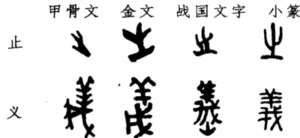Chapter 9 Section 5 Xiaozhuan
The characters of the Qin State in the Warring States period were called "籀 [zhou wrinkled] script" or "Dazhuan [zhuan earn]" by many scholars in later generations. Not too big.This kind of characters can be represented by the "Shigu Wen" unearthed in this area during the Tang Dynasty (Figure 21).

Figure 21 Stone drum rubbings (partial)
At the same time, a font that is easier and quicker to write is also contemplating and spreading among the people of Qin State. A standard container with a capacity of one liter is called "Shang Yang Fangsheng" by later generations. The inscriptions engraved on the wall of the container use this new font (Figure 22).

Figure 22 Shang Yang Fang Sheng inscription (copy)
Qin Shihuang's implementation of "books with the same text" to unify the national characters is based on the above two fonts of Qin State.His prime minister, Li Si, presided over and participated in this work.The whole work is divided into two steps: one is to abolish the various forms of the six languages that are different from those of the Qin State; the other is to simplify, delete, and modify the original Qin script, that is, the shape of the seal script, and at the same time absorb some of the folk fonts. Simplified and vulgar characters should be standardized.In this way, a new official font-Xiaozhuan was formed.According to legend, Li Si himself wrote some steles in Xiaozhuan, such as "Taishan Carved Stone", "Yi [Yi] Mountain Carved Stone" (Fig. 23), "Kuiji Carved Stone", etc., to praise the great achievements of the Qin Dynasty and serve as a A template for this new font.
Chinese characters have developed to the stage of Xiaozhuan, and they have become stereotyped unprecedentedly.
(1) Outline stereotypes: From the inscriptions on oracle bone inscriptions, bronze inscriptions, and Warring States period, the length and size of the inscriptions vary to a basically neat rectangle.Such as:


Figure 23 "Yishan Carved Stone" (partial)
(2) Stroke stereotypes: from oracle bone inscriptions, bronze inscriptions, and Warring States characters, the strokes vary in thickness and thickness, and become evenly rounded lines.Such as:
 (3) Structural stereotypes: The components of oracle bone inscriptions, bronze inscriptions, and Warring States characters can be freely written up, down, left, and right, and become relatively fixed positions, and the phenomenon of the same character having different shapes is also greatly reduced.Such as:
(3) Structural stereotypes: The components of oracle bone inscriptions, bronze inscriptions, and Warring States characters can be freely written up, down, left, and right, and become relatively fixed positions, and the phenomenon of the same character having different shapes is also greatly reduced.Such as:
 The stereotyped Xiaozhuan further weakens the pictographic meaning of Chinese characters, makes Chinese characters more symbolic, and reduces the confusion and difficulty in writing and reading.It is the first time in the history of our country to formally use administrative means to standardize characters on a large scale, and it is also the last step taken by Chinese characters in the stage of ancient characters.
The oracle bone inscriptions, bronze inscriptions, Warring States characters and Xiaozhuan described above are collectively referred to as the ancient characters of Chinese characters today.For the study of ancient Chinese characters, a special discipline has also been formed, called "Paleographology".
The ancient characters of Chinese characters have basically lost their practical functions today, but they still occupy a very important place in the art fields such as calligraphy and seal cutting. Research is of great significance.
The stereotyped Xiaozhuan further weakens the pictographic meaning of Chinese characters, makes Chinese characters more symbolic, and reduces the confusion and difficulty in writing and reading.It is the first time in the history of our country to formally use administrative means to standardize characters on a large scale, and it is also the last step taken by Chinese characters in the stage of ancient characters.
The oracle bone inscriptions, bronze inscriptions, Warring States characters and Xiaozhuan described above are collectively referred to as the ancient characters of Chinese characters today.For the study of ancient Chinese characters, a special discipline has also been formed, called "Paleographology".
The ancient characters of Chinese characters have basically lost their practical functions today, but they still occupy a very important place in the art fields such as calligraphy and seal cutting. Research is of great significance.

Figure 21 Stone drum rubbings (partial)

Figure 22 Shang Yang Fang Sheng inscription (copy)


Figure 23 "Yishan Carved Stone" (partial)


